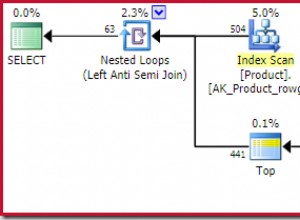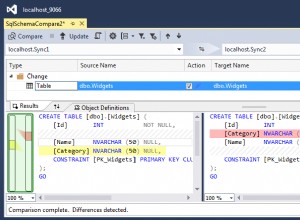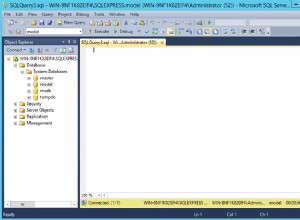Po kilku, być może złośliwych komentarzach, ten problem tkwił w mojej głowie przez cały wieczór i ostatecznie wymyśliłem następujące podejście oparte na zestawach. Uważam, że zdecydowanie kwalifikuje się jako „elegancki”, ale myślę też, że kwalifikuje się jako „trochę głupi”. Ty dzwonisz.
Najpierw ustaw kilka stołów:
-- For testing purposes
DROP TABLE Source
DROP TABLE Numbers
DROP TABLE Results
-- Add as many rows as need be processed--though note that you get N! (number of rows, factorial) results,
-- and that gets big fast. The Identity column must start at 1, or the algorithm will have to be adjusted.
-- Element could be more than char(1), though the algorithm would have to be adjusted again, and each element
-- must be the same length.
CREATE TABLE Source
(
SourceId int not null identity(1,1)
,Element char(1) not null
)
INSERT Source (Element) values ('A')
INSERT Source (Element) values ('B')
INSERT Source (Element) values ('C')
INSERT Source (Element) values ('D')
--INSERT Source (Element) values ('E')
--INSERT Source (Element) values ('F')
-- This is a standard Tally table (or "table of numbers")
-- It only needs to be as long as there are elements in table Source
CREATE TABLE Numbers (Number int not null)
INSERT Numbers (Number) values (1)
INSERT Numbers (Number) values (2)
INSERT Numbers (Number) values (3)
INSERT Numbers (Number) values (4)
INSERT Numbers (Number) values (5)
INSERT Numbers (Number) values (6)
INSERT Numbers (Number) values (7)
INSERT Numbers (Number) values (8)
INSERT Numbers (Number) values (9)
INSERT Numbers (Number) values (10)
-- Results are iteratively built here. This could be a temp table. An index on "Length" might make runs
-- faster for large sets. Combo must be at least as long as there are characters to be permuted.
CREATE TABLE Results
(
Combo varchar(10) not null
,Length int not null
)
Oto procedura:
SET NOCOUNT on
DECLARE
@Loop int
,@MaxLoop int
-- How many elements there are to process
SELECT @MaxLoop = max(SourceId)
from Source
-- Initialize first value
TRUNCATE TABLE Results
INSERT Results (Combo, Length)
select Element, 1
from Source
where SourceId = 1
SET @Loop = 2
-- Iterate to add each element after the first
WHILE @Loop <= @MaxLoop
BEGIN
-- See comments below. Note that the "distinct" remove duplicates, if a given value
-- is to be included more than once
INSERT Results (Combo, Length)
select distinct
left(re.Combo, @Loop - nm.Number)
+ so.Element
+ right(re.Combo, nm.Number - 1)
,@Loop
from Results re
inner join Numbers nm
on nm.Number <= @Loop
inner join Source so
on so.SourceId = @Loop
where re.Length = @Loop - 1
-- For performance, add this in if sets will be large
--DELETE Results
-- where Length <> @Loop
SET @Loop = @Loop + 1
END
-- Show results
SELECT *
from Results
where Length = @MaxLoop
order by Combo
Ogólna idea jest taka:dodając nowy element (powiedzmy "B") do dowolnego ciągu (powiedzmy "A"), aby wychwycić wszystkie permutacje, należy dodać B do wszystkich możliwych pozycji (Ba, aB), w wyniku czego powstanie nowy zestaw smyczki. Następnie wykonaj iterację:Dodaj nowy element (C) do każdej pozycji w ciągu (AB staje się Cab, aCb, abC), dla wszystkich ciągów (Cba, bCa, baC) i masz zestaw permutacji. Powtarzaj każdy zestaw wyników z następną postacią, aż skończą ci się znaki... lub zasoby. 10 elementów to 3,6 miliona permutacji, około 48 MB przy powyższym algorytmie, a 14 (unikalnych) elementów osiągnie 87 miliardów permutacji i 1,163 terabajta.
Jestem pewien, że w końcu może zostać wciśnięty w CTE, ale ostatecznie wszystko, co byłoby, to gloryfikowana pętla. W ten sposób logika jest jaśniejsza i nie mogę powstrzymać się od myśli, że plan wykonania CTE byłby koszmarem.




